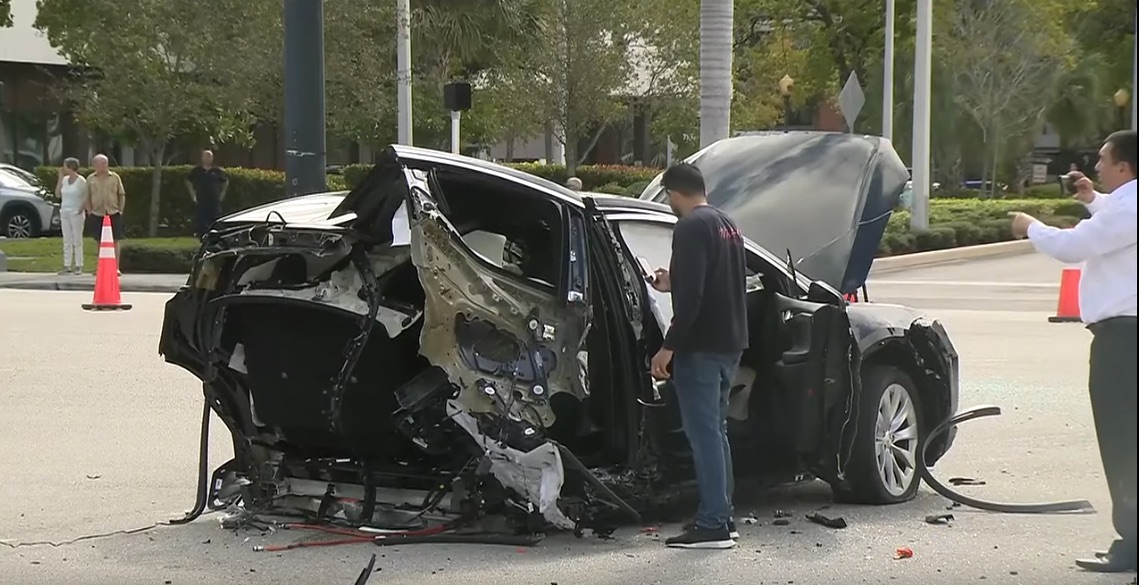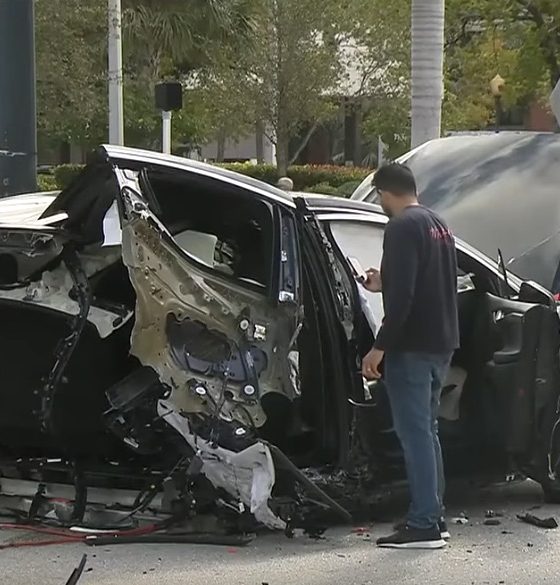

News
Tesla Model X splits in half after blindsided by Nissan GT-R, Tesla driver walks away unscathed
A serious car crash in Hallandale Beach, Florida left a Tesla Model X split in two after a Nissan GT-R alleged ran a red light before slamming into the all-electric SUV at high speed. The driver of the Model X walked away with a minor injury to his leg while the occupants of the other vehicle were brought to nearby hospitals for treatment and are expected to recover.
The driver of the Model X was identified as Jose Diaz who was seen counting his blessings moments after walking away from the incident. In a brief phone interview with 7News Miami, Diaz narrated that the Nissan came so fast that he didn’t even see it and that he just felt the bang.
Eyewitnesses to the scene recall seeing the white Nissan GT-R running through a red light at the intersection of Hallandale Beach Boulevard and Three Islands Boulevard before careening into the rear section of the Tesla Model X.
“I went over to help the guy in the white car, because the car had a lot of smoke, and I thought it was going to blow. He came out unscathed, and he was kissing the floor. It was a little blood coming from his nose, and he said, ‘Oh, I just wanna see my girl,’” said Tony Peart, a witness who approached to help the Tesla driver seconds after the wreck.
- Tesla Model X Florida car crash (Source: 7News Miami)
- Tesla Model X sheers in half after high speed crash (WPLG Local 10 | YouTube)
- Tesla Model X Florida car crash (Source: 7News Miami)
- Tesla Model X Florida car crash (Source: 7News Miami)
While it’s unfortunate to read about serious vehicular accidents, those involving a Tesla put into spotlight the all-electric carmaker’s award-winning safety features. It is very common to see SUVs involved in rollovers when involved in side-impact crashes because of their high center of gravity, but the opposite is true for Tesla vehicles and the Model X. With its low-mounted skateboard design battery pack, the center of gravity is far lower than traditional combustion engine cars, making it virtually impossible to roll over in high-speed crash testing.
The battery pack outer casing also serves as an extra layer of structural rigidity for the vehicle. Combined with a hybrid of ultra-high-strength materials, and large crumple zones that absorb energy to protect occupants from harm, and it’s no wonder that Tesla owners have touted never buying another car other than a Tesla.
“I waited 4 years for this one and would wait 4 more if that is what it took to protect my family like this” recalls one Model X owner after his all-electric SUV saved his life and the lives of his family after being involved in a horrific crash.
The Tesla Model X was awarded a 5-star safety rating in every category by the National Highway Traffic Safety Administration since its debut. Last December, the Model X was a standout in its class for earning the highest overall rating to date in the 2018/2019 protocol of the European New Car Assessment Programme (Euro NCAP) for Large Off-Road Vehicles with a near-perfect score of 98 percent in Adult Occupant Protection category.
Tesla’s Q4 2019 Vehicle Safety Report revealed that its vehicles are still 3 to 4x safer compared to the average even without Autopilot and active safety features enabled. With Autopilot on, the numbers are even more impressive at one accident per 3.07 million miles driven compared to the NHTSA findings of one automobile crash per 479,000 miles in the United States.

News
Tesla (TSLA) receives “Buy” rating and $551 PT from Canaccord Genuity
He also maintained a “Buy” rating for TSLA stock over the company’s improving long-term outlook, which is driven by autonomy and robotics.

Canaccord Genuity analyst George Gianarikas raised his Tesla (NASDAQ:TSLA) price target from $482 to $551. He also maintained a “Buy” rating for TSLA stock over the company’s improving long-term outlook, which is driven by autonomy and robotics.
The analyst’s updated note
Gianarikas lowered his 4Q25 delivery estimates but pointed to several positive factors in the Tesla story. He noted that EV adoption in emerging markets is gaining pace, and progress in FSD and the Robotaxi rollout in 2026 represent major upside drivers. Further progress in the Optimus program next year could also add more momentum for the electric vehicle maker.
“Overall, yes, 4Q25 delivery expectations are being revised lower. However, the reset in the US EV market is laying the groundwork for a more durable and attractive long-term demand environment.
“At the same time, EV penetration in emerging markets is accelerating, reinforcing Tesla’s potential multi‑year growth runway beyond the US. Global progress in FSD and the anticipated rollout of a larger robotaxi fleet in 2026 are increasingly important components of the Tesla equity story and could provide sentiment tailwinds,” the analyst wrote.
Tesla’s busy 2026
The upcoming year would be a busy one for Tesla, considering the company’s plans and targets. The autonomous two-seat Cybercab has been confirmed to start production sometime in Q2 2026, as per Elon Musk during the 2025 Annual Shareholder Meeting.
Apart from this, Tesla is also expected to unveil the next-generation Roadster on April 1, 2026. Tesla is also expected to start high-volume production of the Tesla Semi in Nevada next year.
Apart from vehicle launches, Tesla has expressed its intentions to significantly ramp the rollout of FSD to several regions worldwide, such as Europe. Plans are also underway to launch more Robotaxi networks in several more key areas across the United States.
News
Waymo sues Santa Monica over order to halt overnight charging sessions
In its complaint, Waymo argued that its self-driving cars’ operations do not constitute a public nuisance, and compliance with the city’s order would cause the company irreparable harm.

Waymo has filed a lawsuit against the City of Santa Monica in Los Angeles County Superior Court, seeking to block an order that requires the company to cease overnight charging at two facilities.
In its complaint, Waymo argued that its self-driving cars’ operations do not constitute a public nuisance, and compliance with the city’s order would cause the company irreparable harm.
Nuisance claims
As noted in a report from the Los Angeles Times, Waymo’s two charging sites at Euclid Street and Broadway have operated for about a year, supporting the company’s growing fleet with round-the-clock activity. Unfortunately, this has also resulted in residents in the area reportedly being unable to sleep due to incessant beeping from self-driving taxis that are moving in and out of the charging stations around the clock.
Frustrated residents have protested against the Waymos by blocking the vehicles’ paths, placing cones, and “stacking” cars to create backups. This has also resulted in multiple calls to the police.
Last month, the city issued an order to Waymo and its charging partner, Voltera, to cease overnight operations at the charging locations, stating that the self-driving vehicles’ activities at night were a public nuisance. A December 15 meeting yielded no agreement on mitigations like software rerouting. Waymo proposed changes, but the city reportedly insisted that nothing would satisfy the irate residents.
“We are disappointed that the City has chosen an adversarial path over a collaborative one. The City’s position has been to insist that no actions taken or proposed by Waymo would satisfy the complaining neighbors and therefore must be deemed insufficient,” a Waymo spokesperson stated.
Waymo pushes back
In its legal complaint, Waymo stated that its “activities at the Broadway Facilities do not constitute a public nuisance.” The company also noted that it “faces imminent and irreparable harm to its operations, employees, and customers” from the city’s order. The suit also stated that the city was fully aware that the Voltera charging sites would be operating around the clock to support Waymo’s self-driving taxis.
The company highlighted over one million trips in Santa Monica since launch, with more than 50,000 rides starting or ending there in November alone. Waymo also criticized the city for adopting a contentious strategy against businesses.
“The City of Santa Monica’s recent actions are inconsistent with its stated goal of attracting investment. At a time when the City faces a serious fiscal crisis, officials are choosing to obstruct properly permitted investment rather than fostering a ‘ready for business’ environment,” Waymo stated.
News
Tesla FSD v14.2.2 is getting rave reviews from drivers
So far, early testers have reported buttery-smooth drives with confident performance, even at night or on twisty roads.

Tesla Full Self-Driving (Supervised) v14.2.2 is receiving positive reviews from owners, with several drivers praising the build’s lack of hesitation during lane changes and its smoother decision-making, among others.
The update, which started rolling out on Monday, also adds features like dynamic arrival pin adjustment. So far, early testers have reported buttery-smooth drives with confident performance, even at night or on twisty roads.
Owners highlight major improvements
Longtime Tesla owner and FSD user @BLKMDL3 shared a detailed 10-hour impression of FSD v14.2.2, noting that the system exhibited “zero lane change hesitation” and “extremely refined” lane choices. He praised Mad Max mode’s performance, stellar parking in locations including ticket dispensers, and impressive canyon runs even in dark conditions.
Fellow FSD user Dan Burkland reported an hour of FSD v14.2.2’s nighttime driving with “zero hesitations” and “buttery smooth” confidence reminiscent of Robotaxi rides in areas such as Austin, Texas. Veteran FSD user Whole Mars Catalog also demonstrated voice navigation via Grok, while Tesla owner Devin Olsen completed a nearly two-hour drive with FSD v14.2.2 in heavy traffic and rain with strong performance.
Closer to unsupervised
FSD has been receiving rave reviews, even from Tesla’s competitors. Xpeng CEO He Xiaopeng, for one, offered fresh praise for FSD v14.2 after visiting Silicon Valley. Following extended test drives of Tesla vehicles running the latest FSD software, He stated that the system has made major strides, reinforcing his view that Tesla’s approach to autonomy is indeed the proper path towards autonomy.
According to He, Tesla’s FSD has evolved from a smooth Level 2 advanced driver assistance system into what he described as a “near-Level 4” experience in terms of capabilities. While acknowledging that areas of improvement are still present, the Xpeng CEO stated that FSD’s current iteration significantly surpasses last year’s capabilities. He also reiterated his belief that Tesla’s strategy of using the same autonomous software and hardware architecture across private vehicles and robotaxis is the right long-term approach, as it would allow users to bypass intermediate autonomy stages and move closer to Level 4 functionality.












